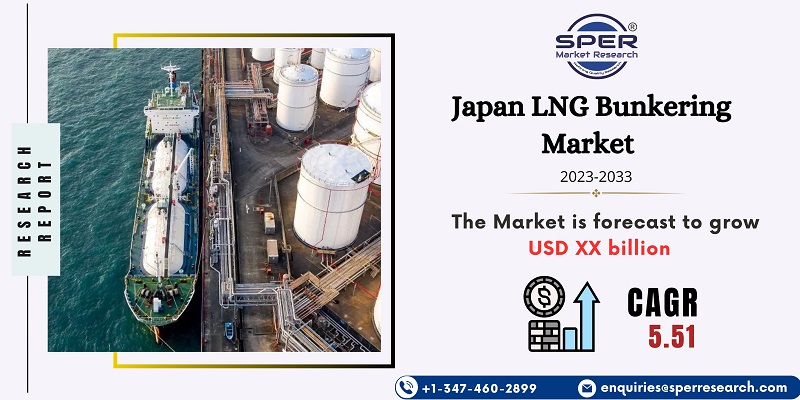
Japan LNG Bunkering Market Growth, Size, Trends, Share, Revenue, Demand and Future Outlook
Japan LNG Bunkering Market Size- By Type, By End User- Regional Outlook, Competitive Strategies and Segment Forecast to 2033
| Published: Nov-2023 | Report ID: POAE2378 | Pages: 1 - 110 | Formats*: |
| Category : Power & Energy | |||
- Japan Petroleum Exploration and Tomakomai Port Authority conducted an LNG bunkering trial in September 2022 with the assistance of Mitsui O.S.K. Lines. The tugboat Ishin, which was utilized for LNG bunkering and was owned by MOL and run by its group company Nihon Tug-Boat, was at issue in this trial.
- Mitsui O.S.K. Lines, Ltd. and ENN Natural Gas Co., Ltd. inked a long-term charter agreement for three new built LNG carriers in September 2022. Delivery of the vessels is scheduled for 2028. Following delivery, the ships' primary function will be to transfer LNG to China that ENN has purchased under a long-term purchase agreement.
 Market Opportunities and Challenges
Market Opportunities and Challenges
| Report Metric | Details |
| Market size available for years | 2019-2033 |
| Base year considered | 2022 |
| Forecast period | 2023-2033 |
| Segments covered | By Type, By End User |
| Regions covered | Eastern Region, Western Region, Southern Region, Northern Region |
| Companies Covered | Nippon Yusen Kabushiki Kaisha, Toyota Tsusho Corporation, Mitsui OSK Lines Ltd., Kawasaki Heavy Industries, Ltd., and Central LNG Marine Fuel Japan Corporation. |
- Shipping Companies and Operators
- Port Authorities and Terminal Operators
- Government and Regulatory Bodies
- Investors and Financial Institutions
- Technology and Equipment Suppliers
- Research and Development Institutions
- End Users and Consumers
| By Type |
|
| Digital Advertising Market |
|
| By Region |
|
- Japan LNG Bunkering Market Size (FY’2023-FY’2033)
- Overview of Japan LNG Bunkering Market
- Segmentation of Japan LNG Bunkering Market By Type (Ship to ship, Terminal to Ship, Truck to Ship)
- Segmentation of Japan LNG Bunkering Market By End User (Defence Vessels, Yachts, Cruise Ships, Ferries & OSVs, Bulk and General Cargo Fleets, Others)
- Expansion Analysis of Japan LNG Bunkering Market
- Problems and Obstacles in Japan LNG Bunkering Market
- Competitive Landscape in the Japan LNG Bunkering Market
- Impact of COVID-19 and Demonetization on Japan LNG Bunkering Market
- Details on Current Investment in Japan LNG Bunkering Market
- Competitive Analysis of Japan LNG Bunkering Market
- Prominent Players in the Japan LNG Bunkering Market
- SWOT Analysis of Japan LNG Bunkering Market
- Japan LNG Bunkering Market Future Outlook and Projections (FY’2023-FY’2033)
- Recommendations from Analyst
1.1. Scope of the report
1.2. Market segment analysis2. Research Methodology
2.1. Research data source2.1.1. Secondary Data2.1.2. Primary Data2.1.3. SPER’s internal database2.1.4. Premium insight from KOL’s
2.2. Market size estimation
2.2.1. Top-down and Bottom-up approach
2.3. Data triangulation
4.1. Driver, Restraint, Opportunity and Challenges analysis4.1.1. Drivers4.1.2. Restraints4.1.3. Opportunities4.1.4. Challenges
4.2. COVID-19 Impacts of the Japan LNG Bunkering Market
5.1. SWOT Analysis5.1.1. Strengths5.1.2. Weaknesses5.1.3. Opportunities5.1.4. Threats
5.2. PESTEL Analysis
5.2.1. Political Landscape5.2.2. Economic Landscape5.2.3. Social Landscape5.2.4. Technological Landscape5.2.5. Environmental Landscape5.2.6. Legal Landscape
5.3. PORTER’s Five Forces
5.3.1. Bargaining power of suppliers5.3.2. Bargaining power of buyers5.3.3. Threat of Substitute5.3.4. Threat of new entrant5.3.5. Competitive rivalry
5.4. Heat Map Analysis
6.1. Japan LNG Bunkering Market Manufacturing Base Distribution, Sales Area, Product Type6.2. Mergers & Acquisitions, Partnerships, Product Launch, and Collaboration in Japan LNG Bunkering Market
7.1. Japan LNG Bunkering Market Value Share and Forecast, By Type, 2023-20337.2. Ship to ship7.3. Terminal to Ship7.4. Truck to Ship
8.1. Japan LNG Bunkering Market Value Share and Forecast, By End User, 2023-20338.2. Defence Vessels8.3. Yachts8.4. Cruise Ships8.5. Ferries & OSVs8.6. Bulk and General Cargo Fleets8.7. Others
9.1. Japan LNG Bunkering Market Size and Market Share
10.1. Japan LNG Bunkering Market Size and Market Share By Type (2019-2026)10.2. Japan LNG Bunkering Market Size and Market Share By Type (2027-2033)
11.1. Japan LNG Bunkering Market Size and Market Share By End User (2019-2026)11.2. Japan LNG Bunkering Market Size and Market Share By End User (2027-2033)
12.1. Japan LNG Bunkering Market Size and Market Share By Region (2019-2026)12.2. Japan LNG Bunkering Market Size and Market Share By Region (2027-2033)12.3. Eastern Region12.4. Western Region12.5. Southern Region12.6. Northern Region
13.1. Central LNG Marine Fuel Japan Corporation13.1.1. Company details13.1.2. Financial outlook13.1.3. Product summary13.1.4. Recent developments
13.2. Chubu Electric Power Co., Inc.
13.2.1. Company details13.2.2. Financial outlook13.2.3. Product summary13.2.4. Recent developments
13.3. Engie SA
13.3.1. Company details13.3.2. Financial outlook13.3.3. Product summary13.3.4. Recent developments
13.4. Kawasaki Heavy Industries, Ltd.
13.4.1. Company details13.4.2. Financial outlook13.4.3. Product summary13.4.4. Recent developments
13.5. Mitsui OSK Lines Ltd
13.5.1. Company details13.5.2. Financial outlook13.5.3. Product summary13.5.4. Recent developments
13.6. Nippon Yusen Kabushiki Kaisha
13.6.1. Company details13.6.2. Financial outlook13.6.3. Product summary13.6.4. Recent developments
13.7. Toyota Tsusho Corporation
13.7.1. Company details13.7.2. Financial outlook13.7.3. Product summary13.7.4. Recent developments
SPER Market Research’s methodology uses great emphasis on primary research to ensure that the market intelligence insights are up to date, reliable and accurate. Primary interviews are done with players involved in each phase of a supply chain to analyze the market forecasting. The secondary research method is used to help you fully understand how the future markets and the spending patterns look likes.
The report is based on in-depth qualitative and quantitative analysis of the Product Market. The quantitative analysis involves the application of various projection and sampling techniques. The qualitative analysis involves primary interviews, surveys, and vendor briefings. The data gathered as a result of these processes are validated through experts opinion. Our research methodology entails an ideal mixture of primary and secondary initiatives.



Frequently Asked Questions About This Report
PLACE AN ORDER
Year End Discount
Sample Report
Pre-Purchase Inquiry
NEED CUSTOMIZATION?
Request CustomizationCALL OR EMAIL US
100% Secure Payment






Related Reports
Our Global Clients
Our data-driven insights have influenced the strategy of 200+ reputed companies across the globe.






















